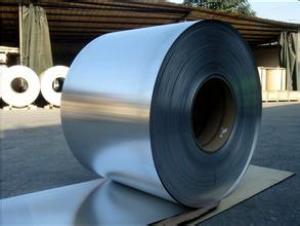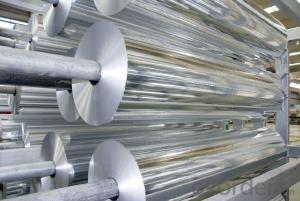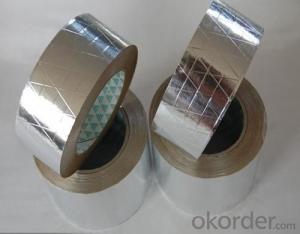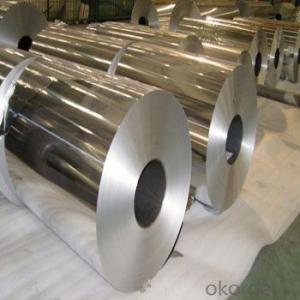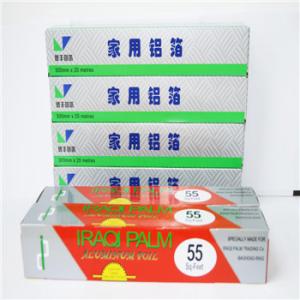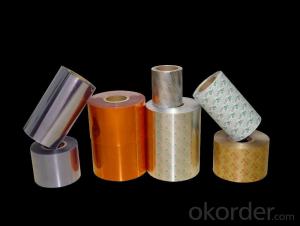Jumbo Aluminum Coil Roll - Aluminium Products
- Loading Port:
- China Main Port
- Payment Terms:
- TT OR LC
- Min Order Qty:
- -
- Supply Capability:
- -
OKorder Service Pledge
Quality Product, Order Online Tracking, Timely Delivery
OKorder Financial Service
Credit Rating, Credit Services, Credit Purchasing
You Might Also Like
Alloy: 1235/ 8011/ 8079
Temper: H14/H16/ H24/ H26
Thickness: 0.28mm-0.3mm(±0.01mm)
Width: 1000mm-2020mm(±1mm)
Core I.D:405/505/508mm
Standard: GB/T3198/ ASTM-B209
SURFACE QUALITY: GOOD APPEARANCE WITH NO-CRACK AND WELL-DISTRIBUTE GRAIN.
BUILD UP: TIGHT SLIT EDGES FREE FROM CRACKS, LAYER TO LAYER SHIFT NOT MORE THAN 2MM.
PROFILE: -0/+1%
FLATNESS: MILL FLATNESS COIL HAVING EDGE WAVINESS RATHER THAN CENTER BUCKLES SHALL BE ACCEPTABLE.
ROLLING PERFORMANCE: RE-ROLLABLE TO THE FINAL DESIRES GAUGES
- Q: What influence do aluminum coils have on the welding process?
- <p>Aluminum coils can significantly affect welding work due to their unique properties. Aluminum has a high thermal conductivity, which requires more heat input to achieve the necessary temperature for welding. It also has a high oxide layer that can interfere with the welding process, leading to porosity and poor joint strength if not properly managed. Additionally, aluminum's low melting point can cause challenges in maintaining the correct temperature during welding. Specialized techniques, such as TIG (Tungsten Inert Gas) welding, and the use of appropriate filler materials are often necessary to ensure a successful weld. Proper cleaning and preparation of the aluminum surface are also crucial to prevent contamination and ensure a strong, defect-free weld.</p>
- Q: How do aluminum coils compare to brass coils in terms of corrosion resistance?
- In terms of corrosion resistance, aluminum coils generally outperform brass coils due to the presence of a natural oxide layer on aluminum's surface. This layer acts as a protective barrier, shielding the metal from moisture and other corrosive elements. On the other hand, brass coils, made from copper and zinc, are more vulnerable to oxidation and corrosion. Although brass coils may develop a protective patina over time, it is not as effective as the oxide layer found on aluminum coils. As a result, aluminum coils are commonly chosen for applications that require high corrosion resistance, such as in marine or coastal environments.
- Q: Can aluminum coils be used in high-magnetic field applications?
- Indeed, high-magnetic field applications can make use of aluminum coils. Being a non-magnetic material, aluminum lacks any magnetic properties, rendering it appropriate for such applications. This is particularly beneficial as the presence of a magnetic field could potentially disrupt the coils' performance or function. Consequently, aluminum coils find wide utilization across diverse industries, such as electrical engineering, aerospace, and automotive, all of which frequently encounter high-magnetic fields. Furthermore, aluminum boasts a lightweight nature and excellent electrical conductivity, making it an optimal selection for applications that necessitate efficient and lightweight coil designs.
- Q: How do I write ionic formula for Sodium Aluminum Silicate? Please explain in a easy way ,,,,,,,,,,,,
- There are literally thousands of different kinds of sodium aluminum silicate, and they do not have simple formulas, because the aluminum and silicon form giant oxygen bridged anions. Most clay minerals are of this type, more or less, although potassium is more common in clays than sodium. So there is no easy way. The empirical formula is sometimes written as a ratio of Na2O to Al2O3 to SiO2, but this gives no information about the structure, only the overall composition. Look up clay minerals online. Wikipedia might be a good start. Also the website mentioned in the other answer.
- Q: What are the precautions to be taken while handling aluminum coils?
- When handling aluminum coils, there are several precautions that should be taken to ensure safety and prevent any potential accidents or damage. Firstly, it is important to wear appropriate personal protective equipment (PPE) such as gloves, safety goggles, and protective clothing. This will help protect against cuts, abrasions, and chemical exposure. Secondly, aluminum coils should be handled with care to prevent any damage or deformation. Avoid dropping or mishandling the coils, as this can affect their structural integrity and potentially cause injuries. Additionally, it is crucial to be aware of the weight of the coils and lift them correctly using proper lifting techniques. If the coils are too heavy to lift safely, it is important to seek assistance or use mechanical lifting equipment to avoid strain or injury. Furthermore, aluminum coils should be stored and transported in a secure and stable manner. They should be placed on a flat, even surface and properly secured to prevent any movement or rolling. When transporting, ensure that the coils are adequately protected from any potential damage or external forces. It is also important to keep the work area clean and free from any clutter or obstacles that may cause accidents. Any spills or leaks should be promptly cleaned up to prevent slips or falls. Lastly, it is crucial to follow all safety guidelines and procedures provided by the manufacturer or employer. This includes understanding the specific properties and hazards associated with aluminum coils and following any recommended handling or storage instructions. By following these precautions, individuals can minimize the risk of accidents, injuries, and damage while handling aluminum coils.
- Q: What are the different coil winding options for aluminum coils?
- There are several coil winding options for aluminum coils, each with its own advantages and applications. 1. Layer Winding: This is the most common and simplest method, where the coil is wound in a single layer. It is cost-effective and suitable for applications where high voltage or high current is required. 2. Disc Winding: In this method, the coil is wound in a disc-like shape, with each layer stacked on top of the previous one. This winding technique allows for better heat dissipation and is often used in high-frequency applications. 3. Helical Winding: Helical winding involves winding the wire in a spiral pattern around the coil form. This method allows for a higher number of turns in a given space, resulting in increased inductance. It is commonly used in applications requiring high inductance, such as transformers and inductors. 4. Interleaved Winding: Interleaved winding is a technique where multiple layers of coil windings are interleaved, meaning one layer is wound in one direction, and the next layer is wound in the opposite direction. This method helps reduce the overall size of the coil and improves its efficiency by reducing the proximity effect. 5. Foil Winding: Foil winding involves using thin layers of aluminum foil instead of wire to create the coil. This method offers better cooling and reduces the overall size of the coil. It is commonly used in high-power applications, such as electric vehicle motors and power generators. 6. Sectional Coil Winding: In this method, the coil is divided into sections, and each section is wound separately. It allows for better control over the coil's shape and size, making it suitable for unique or irregularly shaped applications. The choice of coil winding option depends on factors such as the desired electrical characteristics, space constraints, cooling requirements, and cost considerations. It is important to carefully analyze the requirements of the specific application before selecting the appropriate coil winding technique for aluminum coils.
- Q: What are the various applications of aluminum coil in the construction industry?
- <p>Aluminum coil is widely used in construction for various purposes due to its lightweight, durability, and corrosion resistance. It is commonly used in roofing and siding materials for both residential and commercial buildings, providing a long-lasting and low-maintenance option. Aluminum coil is also utilized in the manufacturing of window frames and doors, offering thermal efficiency and strength. Furthermore, it is used in the production of heat exchangers, solar panels, and electrical wiring due to its excellent conductivity. Additionally, aluminum coil is employed in the fabrication of scaffolding and structural components, contributing to the overall stability and safety of construction projects.</p>
- Q: What are the various dimensions and specifications of aluminum coils available in the market?
- <p>Aluminum coils come in various sizes and specifications to cater to different industrial needs. Common sizes include thicknesses ranging from 0.005 to 0.5 inches (0.13 to 12.7 mm), widths from 1 to 72 inches (25 to 1829 mm), and lengths from 10 to 6000 feet (3 to 1829 meters). The specific dimensions can vary based on the manufacturer and the application, such as construction, automotive, or packaging. It's important to consult with suppliers for the exact sizes available for a particular project or application.</p>
- Q: How do aluminum coils compare to other non-ferrous metals like titanium?
- Aluminum coils and other non-ferrous metals like titanium have distinct characteristics that differentiate them in terms of their properties and applications. While both metals are non-ferrous and share similarities such as excellent corrosion resistance and lightweight properties, they have several differences that set them apart. Firstly, aluminum is more commonly used and readily available compared to titanium. It is also more affordable, making it a cost-effective choice for many industries. Titanium, on the other hand, is relatively rare and expensive due to its complex extraction process, limiting its widespread use. In terms of strength, titanium is significantly stronger than aluminum. Titanium alloys possess exceptional strength-to-weight ratios, making them suitable for applications where high strength is a requirement, such as aerospace and military industries. Aluminum, although not as strong as titanium, is still widely used in various industries due to its good strength-to-weight ratio. Another key difference lies in their melting points. Titanium has a significantly higher melting point compared to aluminum, making it more resistant to high temperatures. This characteristic makes titanium ideal for applications involving extreme heat, such as aircraft engines and components for the chemical industry. Aluminum, on the other hand, has a lower melting point, making it more suitable for applications that require good thermal conductivity, like heat exchangers and electrical wiring. Furthermore, titanium has superior resistance to corrosion compared to aluminum. While aluminum is known for its excellent corrosion resistance, titanium surpasses it in terms of durability, especially in highly aggressive environments, such as saltwater or chemical exposure. This property makes titanium a preferred choice for marine applications, offshore structures, and chemical processing equipment. In summary, aluminum coils and titanium are both valuable non-ferrous metals with unique properties and applications. Aluminum is widely used due to its affordability, availability, and good strength-to-weight ratio, while titanium offers exceptional strength, high-temperature resistance, and superior corrosion resistance at a higher cost. Understanding their differences allows industries to choose the most suitable metal for their specific needs and requirements.
- Q: Are aluminum coils suitable for signage and advertising applications?
- Aluminum coils are indeed suitable for signage and advertising purposes due to their versatility and numerous advantages. To begin with, aluminum is a remarkably versatile material that offers several benefits for these particular applications. Firstly, it is lightweight, making it easy to handle and install, which is particularly advantageous for large-scale signage or advertising displays. Secondly, aluminum is highly durable and resistant to corrosion, ensuring that signage or advertising materials withstand the elements and maintain their appearance over time. Moreover, aluminum can be easily fabricated and customized to meet specific design requirements, allowing for creativity and flexibility in signage and advertising applications. Furthermore, aluminum is an environmentally friendly choice as it is a sustainable material that can be recycled. In conclusion, the characteristics of aluminum coils make them an ideal option for signage and advertising purposes.
Send your message to us
Jumbo Aluminum Coil Roll - Aluminium Products
- Loading Port:
- China Main Port
- Payment Terms:
- TT OR LC
- Min Order Qty:
- -
- Supply Capability:
- -
OKorder Service Pledge
Quality Product, Order Online Tracking, Timely Delivery
OKorder Financial Service
Credit Rating, Credit Services, Credit Purchasing
Similar products
Hot products
Hot Searches
Related keywords
